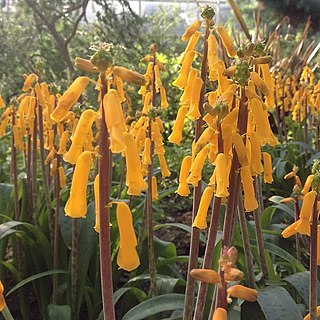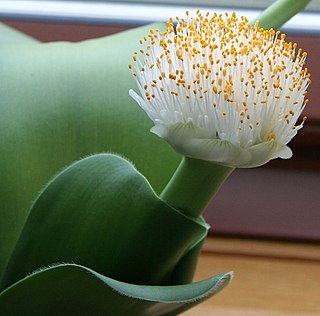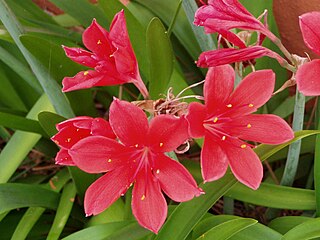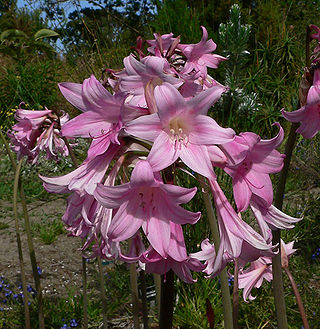
Nerine is a genus of flowering plants belonging to the family Amaryllidaceae, subfamily Amaryllidoideae. They are bulbous perennials, some evergreen, associated with rocky and arid habitats. They bear spherical umbels of lily-like flowers in shades from white through pink to crimson. In the case of deciduous species, the flowers may appear on naked stems before the leaves develop. Native to South Africa, there are about 20–30 species in the genus. Though described as lilies, they are not significantly related to the true lilies (Liliaceae), but more closely resemble their relatives, Amaryllis and Lycoris. The genus was established by the Revd. William Herbert in 1820.

Massonia is a genus of bulbous perennial flowering plants in the family Asparagaceae, subfamily Scilloideae. It is native to southern Africa, and is found in localities such as Namaqualand with hot and dry summers, being dormant in summer and growing during winter. The genus Whiteheadia has been merged into Massonia. It is classed as a cryptophyte.

Lachenalia is a genus of bulbous perennial plants in the family Asparagaceae, subfamily Scilloideae, which are usually found in Namibia and South Africa. Most of them have a dormancy period, but new roots will always grow every year.

Haemanthus is a Southern African genus of flowering plants in the family Amaryllidaceae, subfamily Amaryllidoideae. Members of the genus are known as blood lily and paintbrush lily. There are some 22 known species, native to South Africa, Botswana, Namibia, Lesotho and Eswatini. About 15 species occur in the winter rainfall region of Namaqualand and the Western Cape, the remainder being found in the summer rainfall region, with one species Haemanthus albiflos occurring in both regions.

Ammocharis is a small genus from sub-Saharan Africa, in the family Amaryllidaceae which includes seven species distributed in Africa. The plant grows as above-ground bulb, preferring seasonally wet, hot, sandy soils and full sun.

Cyrtanthus is a genus of perennial, herbaceous and bulbous plants in the family Amaryllidaceae, subfamily Amaryllidoideae.

Ammocharis longifolia is an African species of bulbous flowering plant in the family Amaryllidaceae. It has been placed as the only species, Cybistetes longifolia, in the monotypic genus Cybistetes.

Albuca is a genus of flowering plants in the family Asparagaceae, subfamily Scilloideae. The genus is distributed mainly in southern and eastern Africa, with some species occurring in northern Africa and the Arabian Peninsula. Plants of the genus are known commonly as slime lilies.

Hessea is a genus of bulb-forming plants in the Amaryllis family native to Namibia and South Africa. The genus name commemorates C. H. F. Hesse (1772–1832), who resided in Cape Town from 1800 to 1817.

Namaquanula is a plant genus in the Amaryllidaceae, found only in Namibia and the Cape Province of South Africa.
Strumaria unguiculata is a plant species endemic to Western Cape Province in South Africa.

Amaryllideae are a tribe of subfamily Amaryllidoideae. They are herbaceous monocot perennial flowering plants with a predominantly Southern African distribution, with the exception of the pantropical genus Crinum. They are generally treated as consisting of four subtribes. In addition to Crinum, other genera include Amaryllis, Boophone and Strumaria.

Strumariinae is one of four subtribes within the tribe Amaryllideae, found in southern Africa.

Crininae is one of four subtribes within the tribe Amaryllideae, with a pantropical distribution (Crinum) and also sub-Saharan Africa.

Dierdré "Dee" Anne Snijman is a South African botanist and plant taxonomist who is notable for studying and writing extensively on bulbs. She has described over 120 species and has written comprehensive works on South African flora. She received the 1997 Herbert Medal from the International Bulb Society for her research on Amaryllis.

Strumaria chaplinii is a species of bulbous flowering plant in the family Amaryllidaceae, native to south-west Cape Provinces. It was first described in 1944 as Hessea chaplinii.
Strumaria massoniella is a species of flowering plant in the family Amaryllidaceae, native to the Cape Provinces of South Africa. It was first described in 1985 as Gemmaria massoniella. Its bulb is solitary. Like other members of the genus Strumaria it has star-shaped flowers. In the Northern Cape Province, it is found in sandy plains at an elevation of about 1,000 m (3,300 ft).

Strumaria tenella is a species of flowering plant in the family Amaryllidaceae, native to Lesotho, and the Cape Provinces and Free State of South Africa. It was first described by Carl Linnaeus the Younger in 1782 as Crinum tenellum. Its inflorescence of white flowers has been described as "noticeably starry".

Strumaria watermeyeri is a species of flowering plant in the family Amaryllidaceae, native to the Cape Provinces of South Africa, where it is found in dry areas in the northwest. It is usually solitary, and has pink or white flowers. It was first described by Louisa Bolus in 1921.


















